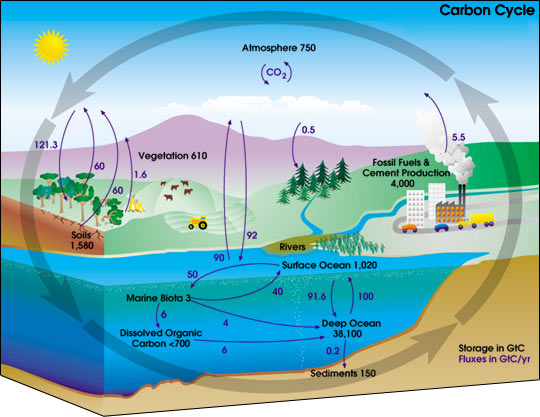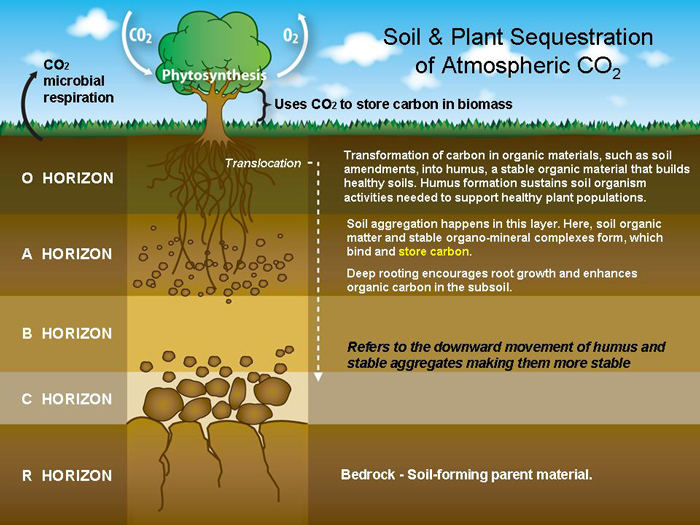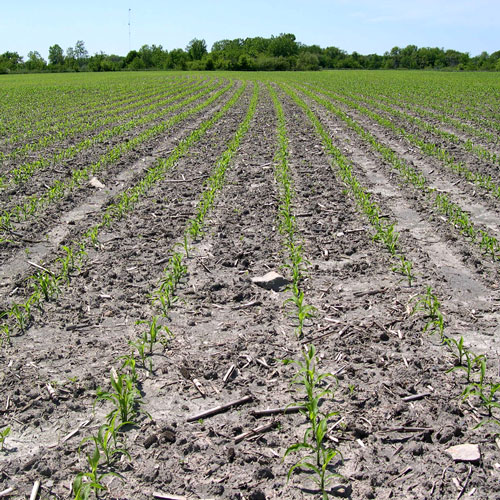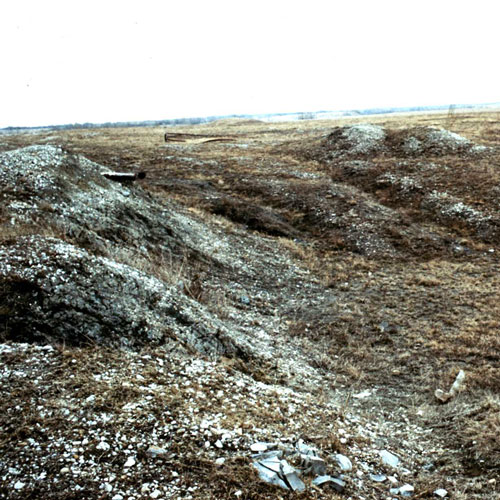
Terrestrial Carbon Sequestration
- Home
- EPA Presentations
- Principles for Ecological Land Reuse
- Soil Science
- Soil Amendments
- Terrestrial Carbon Sequestration
- How is carbon sequestered into the soil?
- What is the carbon cycle?
- Terrestrial carbon sequestration resources
- Plants and Revegetation
- Growing Gardens in Urban Soils
- Ecosystem Services
- Creating Pollinator Habitats as Part of an Ecological Revitalization Project
- Act Locally
- Land Revitalization Assistance
- Case Study Profiles
- Publications, Resources, and Links
- Glossary of Ecological Land Reuse Terms

Introduction
When organic soil amendments are used for remediation and ecological revitalization, one of the associated benefits is terrestrial carbon sequestration. Soils and plants make up the third largest carbon pool, behind the oceanic and fossil carbon pools and may store carbon through physical and chemical processes for thousands of years. Each year carbon is cycled between the atmosphere and the soil/plant pool through photosysnthesis and microbial respiration. Terrestrial carbon sequestration is described as removing CO2 from the atmosphere through enhanced carbon storage in soil and plants. Contaminated sites using soil amendments for remediation benefit climate change efforts to reduce CO2 in the atmosphere through reuse of materials normally disposed (CO2 avoidance) and establishment of healthy soils and plants (terrestrial carbon sequestration). Implementing green remediation best management practices (BMPs) during site remediation and ecological revitalization can help increase carbon sequestration in the project area. Visit the CLU-IN Green Remediation Focus area page for more information on BMPs, practices, and other related information.
Thousands of acres of Superfund sites, Brownfields, mining sites, landfills, and industrial sites with contaminated or disturbed soils exhibit a variety of problems that often can be addressed effectively and directly through the application of soil amendments (EPA, 2007).
Along with achieving EPA's goal of site remediation and reuse, there are many co-benefits gained from ecological land revitalization. There is a host of ecosystem services from a functioning ecosystem (terrestrial carbon sequestration and storage, climate regulation, clean water, natural recreation areas, wildlife habitat, species diversity, pollination, flood and erosion control, food production, fiber, cultural practices, scenic landscapes, soil formation, nutrient cycling, aesthetics, and more). For more information on ecosystem services, please visit the CLU-IN EcoTools page on Ecosystem Services and EPA's webpage on Ecosystem Services Research.
How is carbon sequestered into the soil?
At disturbed sites, the natural processes of soil and plant cycling, respiration, and terrestrial carbon sequestration have been significantly reduced if not ceased entirely. When carbon-rich soil amendments are applied to these sites, the amendments help to jumpstart soil and plant life cycles. Soil amendments provide a high concentration of carbon to carbon-devoid land, so that it is transformed to a favorable environment for soil activity and plant growth. In addition to carbon storage in soils, the now established growth of trees and plants assimilates CO2 from the atmosphere for photosynthesis. Plants also cycle CO2 through their roots into the soil where it is used for soil microbial respiration and stored (i.e. sequestered). These processes lead to the reduction of greenhouse gases in the atmosphere There is both a one-time carbon load at the time of soil amendment application, and an annual terrestrial carbon sequestration rate in the new functioning ecosystem until the carbon reaches saturation. There is also the additional benefit of carbon emission avoidance from reusing organic materials that may have been destined for a landfill and emit CO2 and CH4.
What is the carbon cycle?
The carbon cycle is comprised of all living things (humans, animals, vegetation). Carbon is continuously moving between vegetation, animals, soils, sediments, oceans, and the atmosphere.

Source: Remote Sensing Tutorial, National
Aeronautics and Space Administration.
There are five major reservoirs of carbon interconnected by pathways of exchange: the atmosphere, the terrestrial biosphere (freshwater and soil), oceans, geologic (fossil fuels), and biota. The largest, or oceanic pool, contains 38,000 Pg (Pg petagram = 1 billion metric tons), followed by the geologic pool (comprised of fossil fuel) containing 5000 Pg. The terrestrial C pool is the third largest among the five global C pools containing 2300 Pg to 1-meter depth (comprised of 1550 Pg of soil organic carbon or SOC and 750 Pg of soil inorganic carbon or SIC), the atmospheric pool containing 760 Pg, and, finally, the biotic pool containing 600 Pg of live mass and detritus material. The estimated amount of carbon stored in the world soils is more than twice the carbon in living vegetation (560 petagrams) or in the atmosphere (750 petagrams). Hence, even relatively small changes in soil carbon storage per unit area could have a significant impact on the global carbon balance.
There are two discrete pools in which soil carbon is stored. The short term biomass that is easily decomposed in which carbon may reside for as little as a few weeks, and; the pool in which carbon is more tightly held by physical encapsulation within soil aggregates or chemical complexing that may reside for tens of thousands of years. An average residence time for carbon in soils is 20-30 years. When the carbon content of soils increases, a range of other benefits are appreciated. High carbon soils have better structure and higher nutrient content than lower carbon soils. Plants growing in high carbon soils tend to have higher yields, be more resistent to drought and to disease. High carbon soils are more efficient at receiving and storing rainfall, thereby reducing overland flow and erosion and increasing groundwater storage. In addition to carbon sequestration, increasing soil carbon has a wide range of benefits.
Terrestrial carbon sequestration resources
- 2010 Best Practices for Terrestrial Sequestration of Carbon Dioxide
National Energy Technology Laboratory, U.S. Department of Energy, November 2010
The National Energy Technology Laboratory (NETL) manual, Best Practices for Terrestrial Sequestration of Carbon Dioxide , provides comprehensive guidance on utilizing land-based methods to capture and store carbon dioxide (CO2). Drawing from the experiences of the Regional Carbon Sequestration Partnerships, the manual outlines various land types and management practices that can enhance carbon storage in vegetation and soils. It emphasizes the importance of monitoring, verification and accounting techniques to ensure the effectiveness and permanence of terrestrial carbon storage. It also discusses how these practices have been applied in field projects, offering valuable insights for stakeholders interested in implementing terrestrial COâ‚‚ sequestration strategies.
- Terrestrial Carbon Sequestration: Analysis of Terrestrial Carbon Sequestration at Three Contaminated Sites Remediated and Revitalized with Soil Amendments.
EPA 542-R-10-003. Office of Solid Waste and Emergency Response. U.S. EPA. February 2011.
This paper provides EPA's analysis of the data to determine carbon sequestration rates at three diverse sites that differ in geography/location, weather, soil properties, type of contamination, and age. The first site, located at high elevation in Leadville, Colorado, suffered from contamination due to mining. The site was amended with biosolid cakes, biosolids pellets, biosolid compost, and limestone starting in 1998. The second site, located in Stafford County, Virginia, had highly reduced, high-sulfur soils resulting from construction activities for an airport at the site. When exposed to air, these soils rapidly acidified, causing acid runoff that contaminated local streams. The site was amended with biosolids in 2002. The third site, Sharon Steel, is located at the border of Pennsylvania and Ohio and was contaminated through the application of by-products associated with manufacturing steel. At Sharon Steel, soil amendments were applied as part of a field demonstration project in 2008.
- Terrestrial Carbon Sequestration: Field Guide for Sampling and Analysis at Sites Remediated with Soil Amendments. EPA 542-R-10-002. Office of Solid Waste and Emergency Response. U.S. EPA. June 2010.
The U.S. Environmental Protection Agency (EPA)'s Technology Innovation and Field Services Division developed this field guide to provide a consistent sampling approach across sites being analyzed for terrestrial carbon sequestration. EPA wants to partner with other federal, state, tribal, and local agencies, academia, and other interested parties to build our knowledge of terrestrial carbon sequestration rates. This field guide focuses on a methodology to provide data that can be used in mathematical equations and models to determine terrestrial carbon sequestration rates in soil. Equations in this guide focus on use of carbon data, but the approach provides for a range of parameters that can be used for related carbon sequestration analyses.
- Terrestrial Carbon Sequestration: Field Guide for Sampling and Analysis at Sites Remediated with Soil Amendments. EPA 542-R-10-002. Office of Solid Waste and Emergency Response. U.S. EPA. June 2010.









